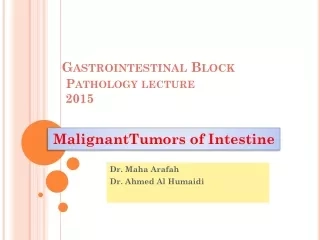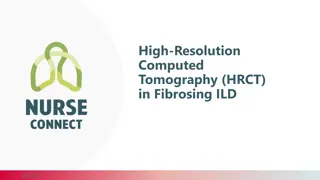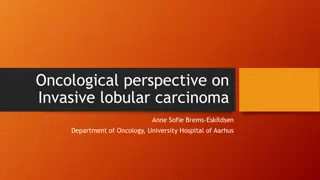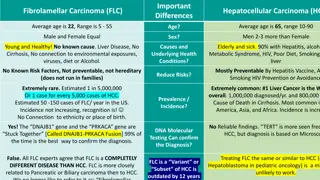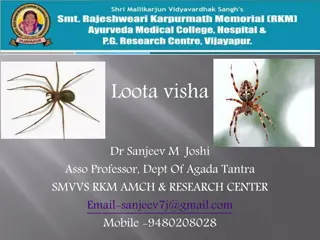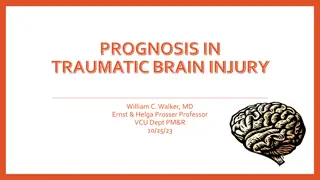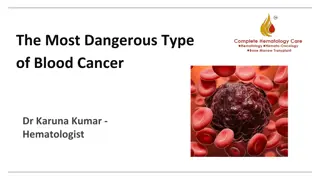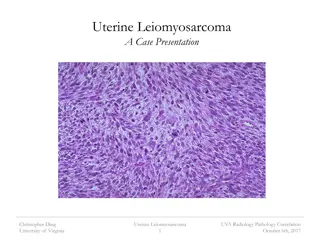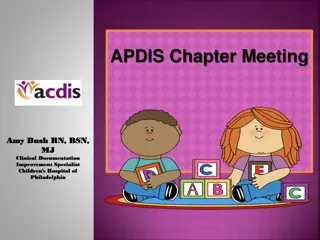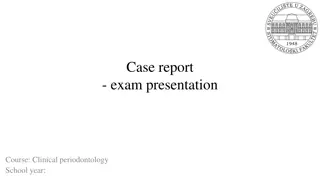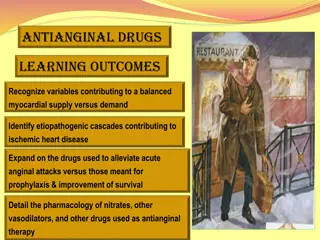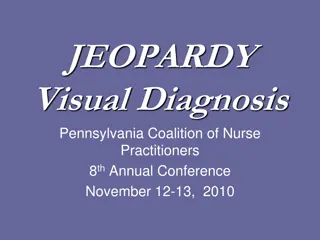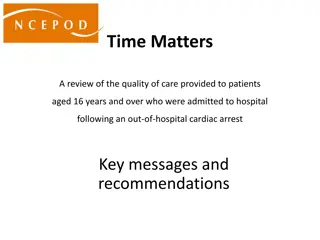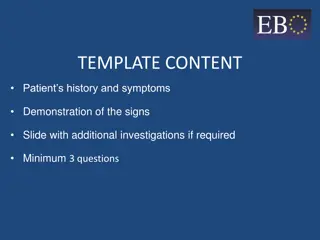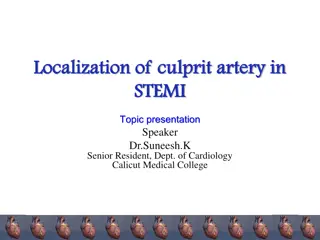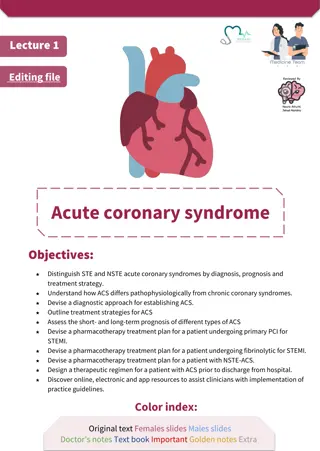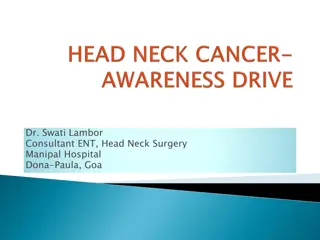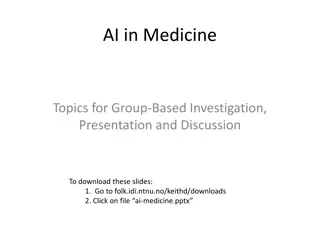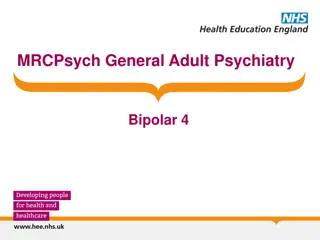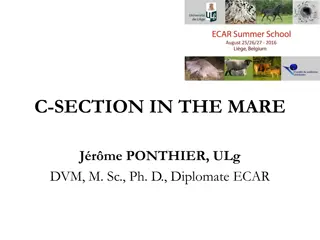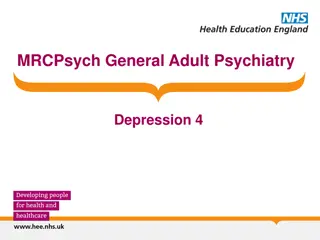MalignantTumors of Intestine
This lecture discusses the epidemiology, pathology, and prognosis of malignant tumors of the intestine, with a focus on colon cancer. It covers the different stages of colorectal adenocarcinoma, the relationship between CEA and recurrence, and the significance of carcinoid tumors.
4 views • 40 slides
Understanding Long Bone Implants and Osteosynthesis Techniques
Fractures in long bones can be categorized based on their form, aiding in prognosis and management. Different types of fractures include comminuted, transverse, oblique, crushing, intra-articular, detachment, and selected fractures. Long bone implants play a crucial role in osteosynthesis, with mate
1 views • 22 slides
Understanding Spondylodiscitis: Diagnosis, Treatment, and Prognosis
Spondylodiscitis is an infectious inflammation affecting the spine's discs and adjacent vertebrae, posing challenges due to potential complications like abscess formation. Early diagnosis and prompt treatment are crucial for a favorable outcome, focusing on infection eradication, pain management, de
0 views • 22 slides
Ventilators market is projected to reach $13.23 billion by 2031
The VNA & PACS Market is projected to reach $6.50 billion by 2031, at a CAGR of 7.2% from 2024 to 2031. Vendor Neutral Archive (VNA) & Picture Archiving and Communication System (PACS) are medical image management solutions used for aiding diagnosis, comparing images between patients or within the s
1 views • 4 slides
Role of High-Resolution Computed Tomography in Fibrosing Interstitial Lung Diseases
HRCT plays a crucial role in diagnosing and monitoring fibrosing interstitial lung diseases (ILDs). It helps identify abnormalities not visible on X-rays, leading to early, accurate diagnoses and potentially avoiding invasive procedures. HRCT assists in distinguishing specific ILDs based on radiogra
1 views • 25 slides
Understanding Endodontic Mishaps in Root Canal Treatment
Endodontic mishaps or procedural accidents are unfortunate occurrences that can happen during root canal treatment, ranging from inattention to detail to unpredictable events. These mishaps can affect the prognosis and may require corrective measures. Classification of mishaps includes accidents dur
1 views • 62 slides
Double-blind, Randomized Trial of Interatrial Shunt in HF Patients
This study details the principal results of the RELIEVE-HF trial, investigating the safety and effectiveness of the V-Wave Ventura interatrial shunt device in patients with heart failure with reduced and preserved ejection fraction. Key inclusion and exclusion criteria are outlined, emphasizing the
0 views • 30 slides
Oncological Perspective on Invasive Lobular Carcinoma: Challenges and Response to Chemotherapy
Guidelines and characteristics of invasive lobular carcinoma, focusing on oncological challenges, response to chemotherapy, and prognosis after neo-adjuvant treatment in patients. Highlights the importance of considering histology type for tailored treatment decisions. Discusses the effectiveness of
0 views • 20 slides
Investigating Visual Perception Effects of Mild Traumatic Brain Injury
Elizabeth Frazier, a PhD student at Purdue University, explores the subtle effects of mild traumatic brain injury (mTBI) on cortical physiology using a novel two-alternative forced choice task in mice. The study aims to bridge visual deficits and cortical circuitry changes post-mTBI to improve diagn
0 views • 5 slides
Understanding the Differences Between Fibrolamellar Carcinoma (FLC) and Hepatocellular Carcinoma (HCC)
Fibrolamellar Carcinoma (FLC) and Hepatocellular Carcinoma (HCC) are distinct liver cancers with important differences in age of onset, underlying causes, diagnostic markers, metastatic patterns, symptoms, treatment options, and outcomes. FLC primarily affects young and healthy individuals with no k
0 views • 4 slides
Understanding Malignant Melanoma: Types, Signs, and Prognosis
Malignant melanoma is a serious skin cancer with various types, including superficial spreading, nodular, acral lentiginous, lentigo maligna, and amelanotic. Recognizing early signs such as ABCDEF (Asymmetry, Borders, Colour, Diameter, Evolving, Funny-looking) is crucial for prompt diagnosis. Macros
2 views • 25 slides
Understanding Enteric Fever (Typhoid Fever): Causes, Contagiousness, and Prognosis
Enteric fever, commonly known as typhoid fever, is an acute illness caused by Salmonella typhi bacteria transmitted through contaminated food or water. This fever is highly contagious, with individuals becoming carriers even after recovering. Close contact, contaminated water, and poor sanitation co
0 views • 18 slides
Understanding Grading and Staging of Malignant Tumors in Cancer Patients
Grading and staging are crucial in determining the aggressiveness and extent of malignant tumors. Grading involves assessing the level of malignancy based on cell differentiation and mitotic activity, while staging considers the size of the tumor, lymph node involvement, and presence of metastases.
7 views • 31 slides
Ayurvedic Approach to Spider Envenomation: Understanding Classification and Treatment
Ayurveda offers a unique perspective on spider bites, categorizing them based on dosha vitiation, poison action, site of venom, and prognosis. This article explores the classification of spider envenomation according to Ayurveda, emphasizing the clinical features and herbal treatment options. Unders
1 views • 20 slides
Enhancing FISH Analysis Sensitivity with Highly Purified Multiple Myeloma Cells
FISH analysis is crucial in multiple myeloma diagnostics, but challenges arise due to low plasma cell detection rates. By isolating CD138+ malignant plasma cells with the EasySep system, sensitivity can be improved for more accurate genetic aberration detection in cytogenetic analyses, aiding in pat
1 views • 12 slides
Understanding Prognosis in Traumatic Brain Injury
Prognosis in traumatic brain injury is influenced by various factors such as population characteristics, impairment levels, and time frames. Predicting short-term and long-term outcomes is crucial for effective patient care, financial planning, and resource utilization. Common outcome measures inclu
0 views • 46 slides
Understanding the Most Dangerous Type of Blood Cancer - Dr Karuna Kumar
Learn about the most dangerous blood cancer: Acute Myeloid Leukemia (AML). Learn its symptoms, treatment challenges, and prognosis in this detailed guide. To know more: \/\/ \/blog\/which-type-of-blood-cancer-is-most-dangerous\/
0 views • 11 slides
Understanding Uterine Leiomyosarcoma: A Case Presentation
A 58-year-old female with a history of fibroids presented with post-menopausal bleeding and was diagnosed with uterine leiomyosarcoma, a rare and aggressive malignancy of uterine smooth muscle cells. The case details the clinical course, diagnosis, and prognosis of this condition, emphasizing the im
0 views • 17 slides
First-in-Class Humanized Anti-DKK2 for Colorectal Cancer
Strong association of clinical biomarker - elevated DKK2 correlates with poor CRC prognosis. First-in-class therapeutic for colorectal cancer, targeting MSS CRC with multiple novel mechanisms of action and low risk for side effects. Complements current treatments like bevacizumab and shows efficacy
2 views • 11 slides
Clinical Documentation Case Study: Posterior Fossa Syndrome and Mutism in Pediatric Patient
A case study of Kaye, a 3-year-old with a posterior fossa mass and obstructive hydrocephalus, highlights the importance of accurate clinical documentation. CDI queries to the physician clarified the distinction between posterior fossa mutism and syndrome, impacting coding accuracy and patient care o
4 views • 11 slides
Understanding Azoturia in Horses: Causes, Symptoms, and Treatment
Azoturia, also known as exertional rhabdomyolysis or tying-up syndrome, is a multifactorial myopathy that mainly affects draft horses. It is characterized by stiffness in gait, reluctance to move, lameness, and myoglobinuria. The disease typically occurs during exercise after a period of rest and ca
0 views • 14 slides
Extended Endocrine Therapy Guidelines for Breast Cancer Patients
Extended adjuvant endocrine therapy may benefit breast cancer patients with poor or intermediate prognosis, but may have little value for those with good prognosis. Risks include osteoporosis and venous thromboembolism. Different treatment options are available for postmenopausal and premenopausal w
0 views • 9 slides
Comprehensive Clinical Periodontology Case Study Presentation
This comprehensive clinical periodontology case study presentation includes detailed information on the patient's general and dental history, oral hygiene assessment, periodontal diagnostics, radiographic analysis, occlusion evaluation, periodontal risk assessment, diagnosis, therapy plan, surgical
0 views • 15 slides
Understanding Antianginal Drugs and Treatment Options
Recognize the variables contributing to balanced myocardial supply and demand, identify etiopathogenic cascades in ischemic heart disease, and learn about drugs for acute angina relief and prophylaxis. Delve into the pharmacology of nitrates, vasodilators, and other antianginal therapies. Explore th
2 views • 18 slides
Pediatric Dermatology Guide for Nurse Practitioners
Explore visual diagnosis challenges from the Pennsylvania Coalition of Nurse Practitioners' annual conference in 2010, covering topics such as neonatal acne, seborrheic dermatitis, and eczema/atopic dermatitis in infants. Enhance your knowledge on common skin conditions affecting newborns and learn
0 views • 63 slides
Understanding Sand Crack in Cattle Hooves: Causes, Signs, and Treatment
Sand crack, a fissure of the horny wall in cattle hooves, can present transversely or longitudinally. It commonly affects dairy breeds and is predisposed by various factors such as overgrowth of digital horn and chronic laminitis. Diagnosis and treatment differ based on the form of the crack, with s
0 views • 10 slides
Reflections on Time, Life, and Death in "The Iceberg" and "Living in Prognosis
The texts explore the intertwining themes of time, life, and death through personal narratives and critical analysis. "The Iceberg" delves into the urgency of facing the future, while "Living in Prognosis" challenges traditional views on time and mortality, presenting a poignant reflection on the im
2 views • 6 slides
Dental Health Assessment and Treatment Overview
This comprehensive dental assessment covers personal history, gum and bone health, medication details, and periodontal risk assessment. The evaluation includes questions about dental fears, experiences, gum conditions, and more. Visual aids and images help in understanding the examination process an
0 views • 35 slides
Quality of Care for Patients Following Out-of-Hospital Cardiac Arrest
This review focuses on the quality of care provided to adult patients aged 16 years and older who were admitted to the hospital after experiencing an out-of-hospital cardiac arrest. Key messages highlight the importance of strategies for rapid and high-quality resuscitation, documentation of advance
0 views • 24 slides
Patient's History and Symptoms Analysis with Investigative Approach
Explore a patient's history and symptoms presentation, followed by sign demonstration and additional investigations. Formulate probable reasons, likely diagnosis, and discuss prognosis and risks for children. Includes minimum 3 key questions for analysis.
0 views • 5 slides
Understanding B-Cell Prolymphocytic Leukaemia and CLL-Related Conditions
B-cell prolymphocytic leukaemia (B-PLL) is a rare disorder that mainly affects older patients, presenting with splenomegaly and high white blood cell counts. CLL-related conditions like Monoclonal B-cell lymphocytosis and Richter's syndrome can further complicate the prognosis, especially in elderly
0 views • 23 slides
Understanding Culprit Artery Localization in STEMI: Insights from a Cardiology Presentation
Dr. Suneesh K., a Senior Resident in the Dept. of Cardiology at Calicut Medical College, delves into the crucial role of ECG analysis in identifying the culprit artery during ST-elevation myocardial infarction (STEMI). This presentation covers coronary circulation, blood supply of the heart, prevale
0 views • 83 slides
Understanding Acute Coronary Syndrome Differentiation and Treatment
Learn to distinguish between STE and NSTE acute coronary syndromes in terms of diagnosis, prognosis, and treatment strategies. Understand the pathophysiological differences between ACS and chronic coronary syndromes. Gain insight into diagnostic approaches, treatment regimens, and prognosis for vari
0 views • 15 slides
Comprehensive Overview of Head and Neck Cancer by Dr. Swati Lambor, ENT Consultant
Cancer of the head and neck region poses a significant threat, with various types of tumors affecting areas like the nasal cavity, paranasal sinuses, mouth, larynx, salivary glands, and thyroid. Dr. Swati Lambor, a skilled ENT consultant at Manipal Hospital in Goa, sheds light on the causes, progres
0 views • 72 slides
Innovations in AI Applications for Group-Based Medical Investigation
Exploring the diverse applications of artificial intelligence (AI) in the field of medicine, this presentation delves into topics such as AI in disease diagnosis/prognosis, molecular data analysis, disease treatment/drug development, and utilizing Watson from IBM. It also discusses the role of AI in
0 views • 6 slides
Abdul's Journey: Contrasting Standard and Optimal Healthcare Pathways
Abdul's story illustrates the stark contrast between a sub-optimal healthcare pathway, leading to chronic kidney disease and multiple complications, and an optimal pathway where early detection and intervention improved his prognosis. Neglecting follow-up appointments and ignoring symptoms resulted
0 views • 10 slides
Understanding Bipolar Disorder: Course, Prognosis, and Treatment
Develop a comprehensive understanding of Bipolar disorder, including its course, prognosis, and risk factors for poor outcomes. Explore the prevalence, time course, and intensity of the disorder, as well as different types and changes in presentation over time. Gain insights from expert-led sessions
0 views • 29 slides
Understanding Brain Tumors: Classification, Clinical Features & Prognosis
Brain tumors, whether primary or secondary, present with various clinical features such as neurological deficits, seizures, and raised intracranial pressure. The classification includes common types like gliomas, meningiomas, and medulloblastomas. Astrocytomas are the most common primary intracrania
0 views • 22 slides
Understanding C-Section in Mares: Procedure, Post-Surgery Care, and Prognosis
Learn about the C-section procedure in mares, including surgery techniques, post-surgery care for both mare and foal, and different scenarios that may require a C-section. Explore the differences between mare and bovine procedures, forecasted C-section situations, and factors influencing prognosis.
0 views • 19 slides
Understanding the Course and Prognosis of Depression in Adults
Developing an understanding of the course and prognosis of depression is crucial for making informed treatment decisions, assessing risks for poor outcomes, and estimating social consequences. The onset of depression can occur at any time in life, with varying outcomes unique to each patient. Early
0 views • 30 slides
